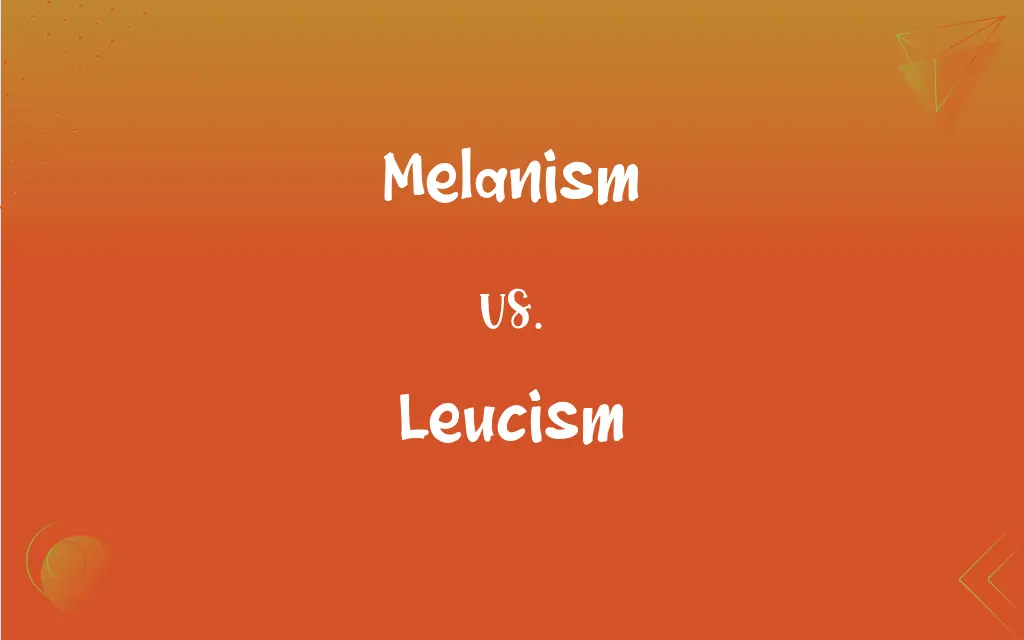Melanism vs. Leucism: What's the Difference?
Edited by Aimie Carlson || By Janet White || Published on February 13, 2024
Melanism is an increased dark pigment in animals' skin, fur, or feathers, while leucism is a partial loss of pigmentation, leading to white, pale, or patchy coloration without affecting eye color.

Key Differences
Melanism is a genetic condition characterized by an overabundance of melanin, the dark pigment responsible for coloration in animals. This results in a predominance of black or dark coloration in skin, fur, or feathers. Leucism, on the other hand, is a condition where there is a partial loss of pigmentation. Unlike albinism, leucism does not affect the color of the animal's eyes, and it results in white, pale, or patchy coloration in skin, fur, or feathers.
Melanism can occur in various species and is often seen as an evolutionary adaptation to certain environments, such as in dense forests or volcanic regions, where darker coloration offers better camouflage. Leucism, in contrast, is generally not advantageous in the wild, as it can make animals more visible to predators and less successful in hunting, due to their unusual appearance.
In melanism, the animal's entire body or large parts of it may be affected, leading to a uniformly dark appearance. This is due to the widespread presence of melanin. In leucism, the distribution of the loss of pigmentation can vary greatly, from full-body pallor to irregular, patchy spots where normal coloration is absent.
Melanism is often mistaken for albinism, but unlike albinism, which results in a complete lack of pigment and red or pink eyes, melanism leads to increased pigment. Leucism is also often confused with albinism, but unlike albinos, leucistic animals retain their normal eye color, which is a key differentiator.
Both melanism and leucism are genetic anomalies, but they affect animals in distinct ways. While melanism results in an excess of dark pigment, leucism results in reduced pigmentation. Both conditions are subject to the forces of natural selection and can influence an animal's survival and reproductive success.
ADVERTISEMENT
Comparison Chart
Definition
Excess of dark pigment
Partial loss of pigmentation
Effect on Color
Darkens skin, fur, feathers
Causes white, pale, or patchy coloration
Impact on Eyes
Does not affect eye color
Does not affect eye color (unlike albinism)
Adaptive Value
Can be advantageous for camouflage
Often not advantageous in the wild
Confusion With
Often mistaken for albinism
Often mistaken for albinism
ADVERTISEMENT
Melanism and Leucism Definitions
Melanism
A genetic adaptation resulting in darker coloration in animals.
Melanism in moths became prevalent during the Industrial Revolution due to pollution.
Leucism
A genetic condition leading to decreased pigment production, causing pale or spotty appearances.
The lion's cub showed signs of leucism, with patches of white in its fur.
Melanism
An increase in black or dark pigmentation in an animal's skin, fur, or feathers.
The panther's melanism provides excellent camouflage at night.
Leucism
Reduced pigmentation resulting in pale or patchy coloration in skin, fur, or feathers.
Leucism in birds can result in unusually pale plumage.
Melanism
A condition where animals have more dark pigment than usual.
Melanism in leopards is rare but striking in appearance.
Leucism
The occurrence of reduced melanin, leading to paler or uneven coloration.
A leucistic penguin was spotted, its plumage much paler than its peers.
Melanism
The occurrence of unusually high levels of melanin in animals.
Birds with melanism are less common but visually striking.
Leucism
A condition causing partial loss of pigmentation in animals, leading to white or patchy coloration.
The deer's leucism made it stand out in the forest.
Melanism
An excess of melanin production leading to predominantly dark appearances in animals.
The jaguar's melanism is a rare trait, making it a unique specimen.
Leucism
Partial pigmentation loss in animals, not affecting eye color.
The peacock's leucism gave it a unique, patchy feather pattern.
Melanism
See melanosis.
Leucism
A partial loss of pigmentation in a human or other animal, resulting in white, pale, or patchy coloration of the skin, hair, fur, or feathers but not the eyes.
Melanism
Dark coloration of the skin, hair, fur, or feathers because of a high concentration of melanin.
Leucism
An animal condition in which there is partial loss of pigmentation resulting in white, pale, or patchy coloration of the skin, hair, feathers, scales or cuticle, but not the eyes (caused by a reduction in multiple types of pigment, not just melanin).
Melanism
Congenital excess of melanin pigmentation in the skin, hair, feathers and/or eyes.
Melanism
An undue development of dark-colored pigment in the skin or its appendages; - the opposite of albinism.
Melanism
A disease; black jaundice. See Melæna.
Melanism
The character of having a high degree of pigmentation, as shown in dark skin, eyes, and hair.
Melanism
A condition characterized by abnormal deposits of melanin (especially in the skin)
FAQs
Can melanism affect all animals?
Melanism can occur in various animals, including mammals, birds, and reptiles.
What causes melanism?
Melanism is caused by genetic factors leading to increased melanin production.
What is melanism?
Melanism is an excess of dark pigmentation in animals.
Is melanism advantageous?
In some environments, melanism can offer better camouflage and survival advantages.
How does melanism differ from albinism?
Melanism involves increased pigmentation, while albinism is a lack of pigmentation.
What is leucism?
Leucism is a partial loss of pigmentation in animals.
Can leucism be cured or reversed?
No, leucism is a genetic condition and cannot be cured or reversed.
Is leucism the same as albinism?
No, leucism differs from albinism in that it doesn't affect eye color and is a partial pigment loss.
How common is melanism in the wild?
Melanism's frequency varies greatly among species and environments.
Can leucism be seen in all animals?
Leucism can occur in various species, but its visibility depends on the animal's original coloration.
Do leucistic animals face challenges in the wild?
Yes, their unusual coloration can make them more visible to predators or affect their hunting ability.
Can leucism affect an animal's behavior?
Leucism itself doesn't affect behavior, but the animal's interactions with others might be influenced by its appearance.
Is melanism more common than leucism?
The prevalence of each condition varies by species and is not universally comparable.
What causes leucism?
Leucism is caused by genetic factors that reduce pigment production.
Can melanistic animals have normal-colored offspring?
Yes, depending on the genetics, melanistic animals can have offspring with standard coloration.
Does leucism affect eye color?
No, leucism does not affect the color of an animal's eyes.
Are melanism and leucism hereditary?
Both conditions are genetic and can be passed down to offspring.
Are there any famous examples of melanistic animals?
The black panther, a melanistic variant of leopards or jaguars, is a well-known example.
Are leucistic animals always white?
No, leucistic animals can have patchy or partial white coloration, not necessarily entirely white.
Are animals with melanism healthy?
Yes, animals with melanism are generally as healthy as their non-melanistic counterparts.
About Author
Written by
Janet WhiteJanet White has been an esteemed writer and blogger for Difference Wiki. Holding a Master's degree in Science and Medical Journalism from the prestigious Boston University, she has consistently demonstrated her expertise and passion for her field. When she's not immersed in her work, Janet relishes her time exercising, delving into a good book, and cherishing moments with friends and family.
Edited by
Aimie CarlsonAimie Carlson, holding a master's degree in English literature, is a fervent English language enthusiast. She lends her writing talents to Difference Wiki, a prominent website that specializes in comparisons, offering readers insightful analyses that both captivate and inform.
































































